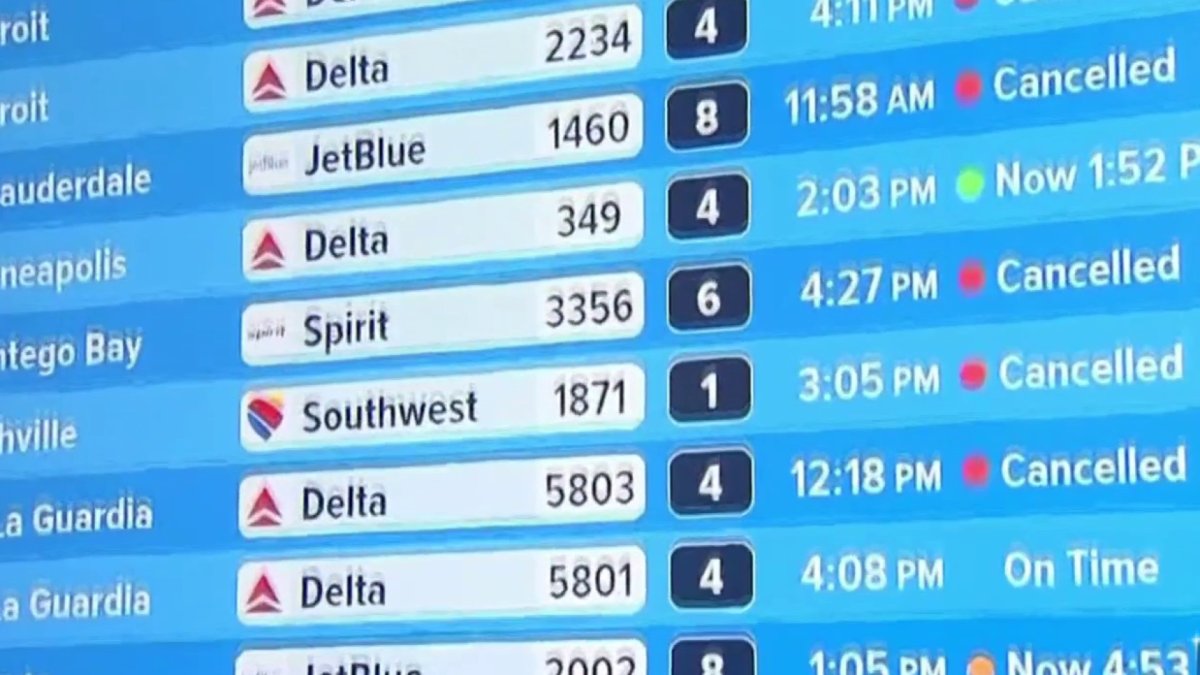
While some planes got out early this morning, flight cancellations grew at Bradley Airport throughout the day.
From the roads to the air, Tuesday’s nor’easter had an impact on anyone who had to get around.
Bradly International Airport had 40 percent of its flights cancelled as of 4:30 p.m., while more than 600 Department of Transportation crews work to clear roads across the state.
Some travelers at the airport felt the double impact, dealing with both flight delays and slick roads.
“It was dead quiet on the way down here, I think we had one car that was on the road with us,” said Dave Amick, of Anchorage, Alaska.
Get Connecticut local news, weather forecasts and entertainment stories to your inbox. Sign up for NBC Connecticut newsletters.
For two groups at Bradley Airport, a long day of travel started with a snowy drive from Massachusetts to Connecticut.
“Driving in, it kept getting worse and worse,” said Elizabeth Santos, of Northampton, Massachusetts.
Amick is optimistic that his flight will get the family back to Alaska.
“So far ours is scheduled to get us home. So we’re crossing our fingers!” he said. "We're hoping to avoid hotels, and just get on the plane, and catch our flights home."
On the other hand, Santos is eager to head to sunnier skies in Orlando, Florida, but spent the afternoon facing flight delays.
“I’m ready to just rebook til tomorrow, but he said no let’s wait and see what happens,” she said. “At this point, we figure what are we going to do? Might as well just stay here.”
Airport officials say crews have been working on snow removal since the early morning, and airport has remained open throughout the day. As of 4:30 p.m. Tuesday, 40 percent of flights were cancelled, as airlines adjust their schedules in response to the storm.
“We’re encouraging passengers to really stay in close contact with airlines on their respective flight,” Alisa Sisic, Connecticut Airport Authority PIO, said. “Even if you’re not seeing snow at home, you should still be checking in with your airline to confirm that your flight is on time.”
For those traveling by car, road conditions vary across the state.
“We have everything from inches and inches of snow to wet road conditions down on the shoreline. So it's a plethora of different road conditions everywhere,” said Sgt. Christine Jeltema, of the Connecticut State Police.
From midnight to 4:30 p.m., Connecticut State Police responded to 98 weather-related accidents with no reported injuries, and another 10 with injuries that are not serious. There are no reported fatalities or serious injuries.
State Police have responded to 153 traffic incidents, including disabled vehicles and spinouts. This morning in Enfield, they assisted vehicles stuck in the snow.
“The road conditions can change suddenly,” Sgt. Jeltema said.
Early Tuesday Governor Ned Lamont, issued a ban on tandem tractor trailers and empty trailers on I-84, but lifted the ban at 3:30 p.m.
As of Tuesday afternoon, there were 621 trucks clearing state roads, including 606 CTDOT crews, and another 15 private contractors in the northwest hills.
“We've also seen some downed trees on the roadways, downed power lines,” said Shannon Burnham, as spokesperson for the Department of Transportation. “We weren't able to treat the roads, because that would have just been washed away with the rain. But crews have been out since very early this morning, late last night, clearing the roadways, making sure we can see the blacktop, and addressing areas of the state that have seen a significant amount of snowfall.”
Some New Englanders were still ready to venture out.
“My car was covered in snow!” said Mackenzie Thompson, of Windsor Locks. “I didn’t have a brush, so I just warmed it up, and then just kind of wiped it off with a bag.”
Others are embracing the weather, like a rideshare driver who planned to be out for 10 hours throughout the day.
“Wintertime is winter!” Osmn Odabas said. “Specifically in this time, it’s good for us, because many drivers, you know they’re scared and they don’t want to drive.”
The DOT also reminds drivers to stay back at least 300 feet from crews clearing the roads to give them space to work. They say drivers should be cautious as temperatures drop overnight and there is a higher chance of the roads getting icy.